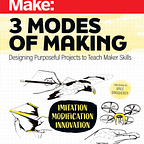Making for Social Good
I’ve recently started teaching a new class in the Makerspace called Making for Social Good. It seems to me that often we surround our school Makerspaces in the language of entrepreneurship; innovation, design thinking, user experience. When I talked to people about my course idea several people told me how great social entrepreneurship is. Companies like Toms shoes and Newman’s Own donate money or products every time one of their products are purchased. This model of “we do good when we do well” is a fantastic development in social causes, and I love working with out entrepreneurship students to develop a product, but it wasn’t what I had in mind for this course. I want to use those same Makerspace concepts within a service learning context.
When I was in high school I took a service learning class. In addition to various service projects we learned about different types of service; direct, indirect and advocacy. Direct service is showing up at an organization or working directly with a population with needs. Indirect service supports those who do work directly with a population in need, either through providing training, money or other material support. Advocacy is raising awareness for a cause or need. It doesn’t take long to see how a Makerspace can fit within these various models. You can create an object or design that meets a direct need for the community you are trying to help, you can create an object that helps an organization that works in the community, and you can create an object that raises awareness of the issue within the community. The ability of Makerspaces to create digital designs that can be shared and produced in other Makerspaces can leverage the idea within a local, national or even global community.
The class that I have designed will focus on the following five skills within a service learning context:
- Human Centered Design
- Youth-led Participatory Action Research (YPAR)
- Rapid Prototyping and Iteration
- Digital Fabrication
- Measuring impact in the real world
Human Centered Design
Often designs are created based on what is cost-effective, possible technologically, or most easily manufactured. While all of these considerations are important, Human Centered Design focuses first on the human users of a particular object. A cost-effective product that people do not like to use is doomed to fail. The design firm IDEO is one of the pioneers of the Human Centered Design. See some of their projects for social good at IDEO.org.
Youth-Led Participatory Action Research (YPAR)
Human Centered Design relies heavily on gaining a strong understanding of the needs of the end user. YPAR is a framework that helps students identify a need they feel strongly about, directly connect with people who might benefit from their project and evaluate how well their ideas are meeting the stated objectives. Berkeley’s YPAR Hub is a great resource for activities to assist YPAR.
Rapid Prototyping and Iteration
Designing an object that meets the needs of the target group requires as many opportunities to test in the real world as possible, so the quicker a functional prototype is ready to test, the more variations can be made to reach the best possible final product. Gathering feedback on each successive iteration will help improve the final design.
Open Source Digital Fabrication
Whether the final design is 3D printable, CNC machined or made from recycled parts with a video tutorial, the ability to share out specific and helpful instructions so that others can replicate the object is critical to the Making for Social Good project. Digital fabrication allows the project to leverage the community of makers to create the object at a regional, national or global scale. The E-nable prosthetic project is an excellent example of this process.
Measuring Impact
Finding ways to measure the impact of the final design is another step in the iterative process. Understanding how an object is being used in the real world by its intended audience will help others know under what circumstances the design might succeed or fail, and what elements might need to change or evolve to meet other needs. The ability to think about the continued impact of the design and to measure its impact is essential to creating a sustainable project.
By doing a variety of design challenges and skill development activities, my hope for this class is that the students will be able to identify a need within a community that they want to and are able to address, have them research and gain a deep understanding of the problem from the perspective of those who are affected by it, have them design and improve an object that can address that need, and finally, share it with the world so it can be used by others.
I will be blogging periodically about how the class is progressing and what lessons I have been learning in the process.
